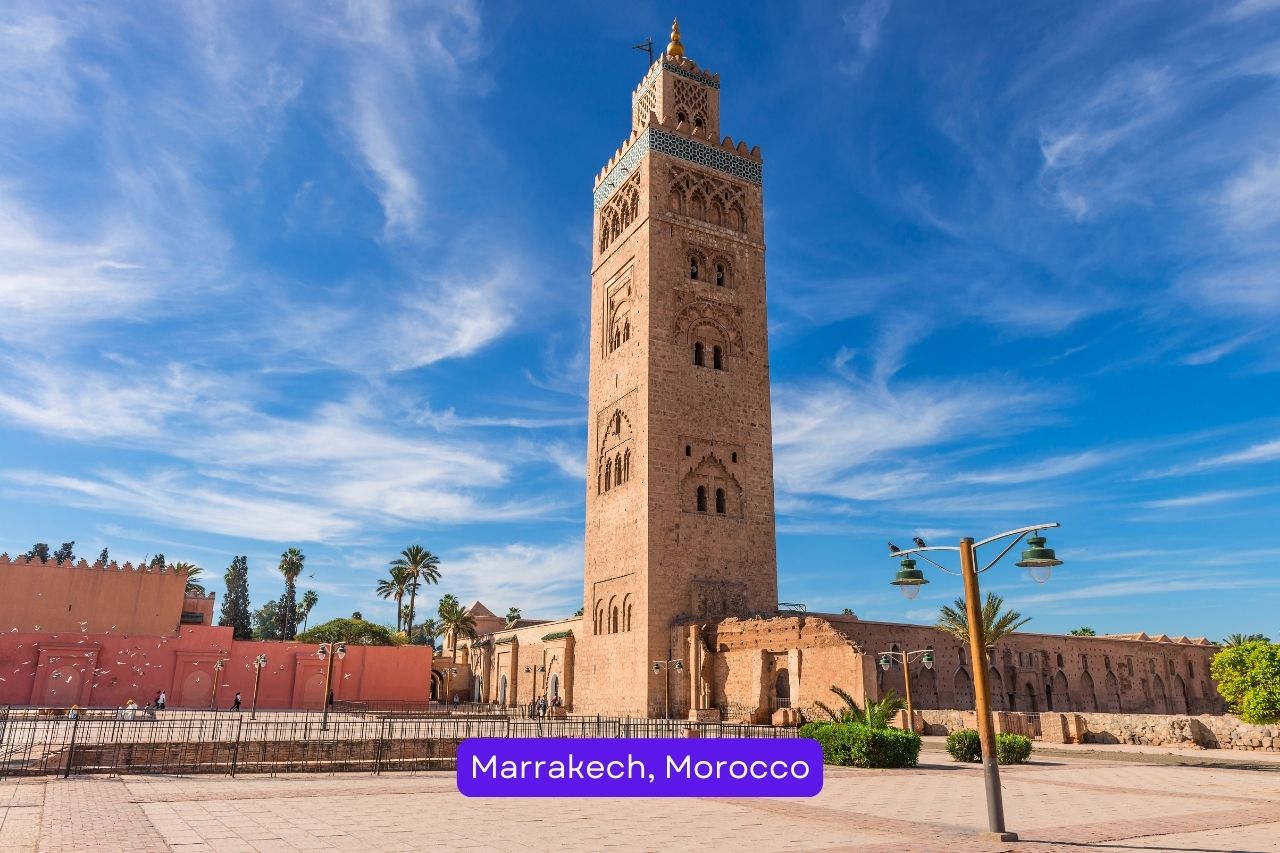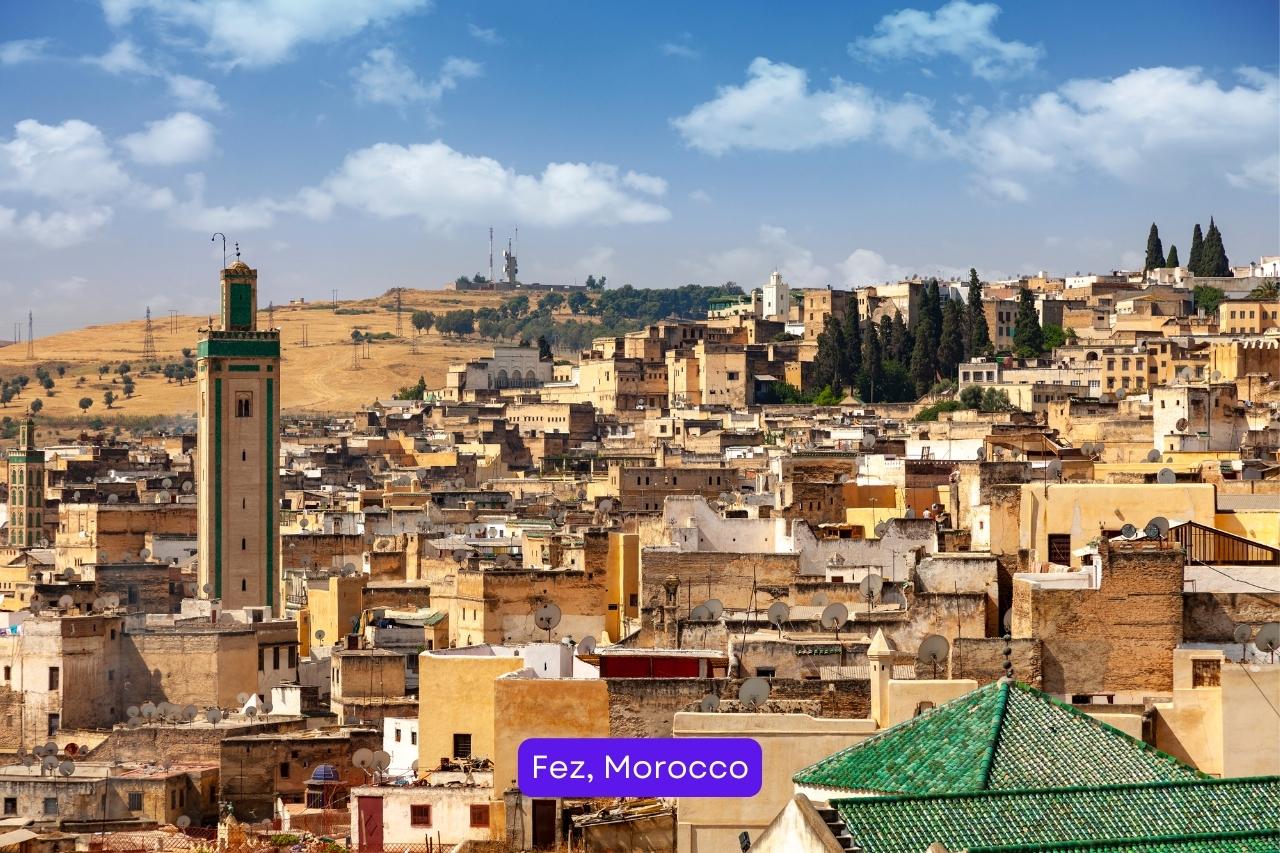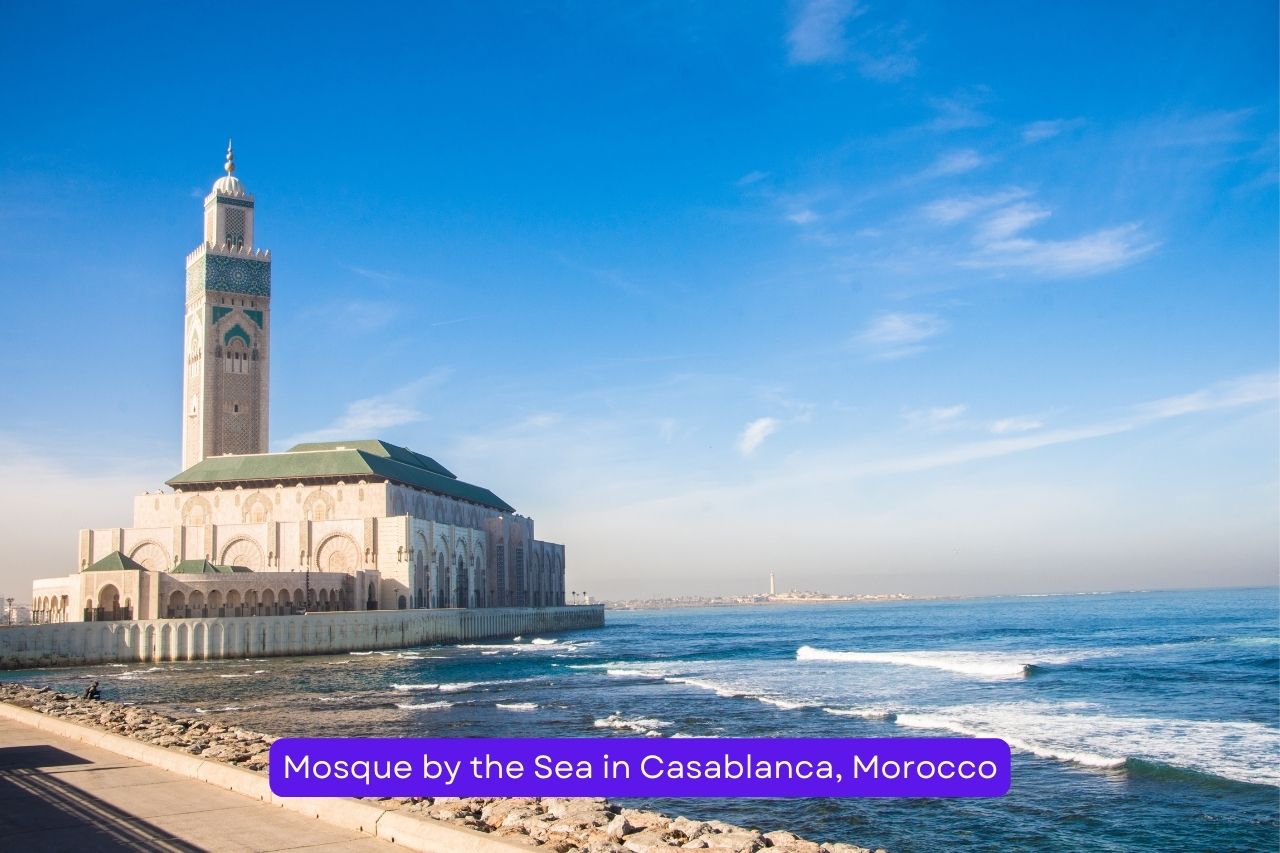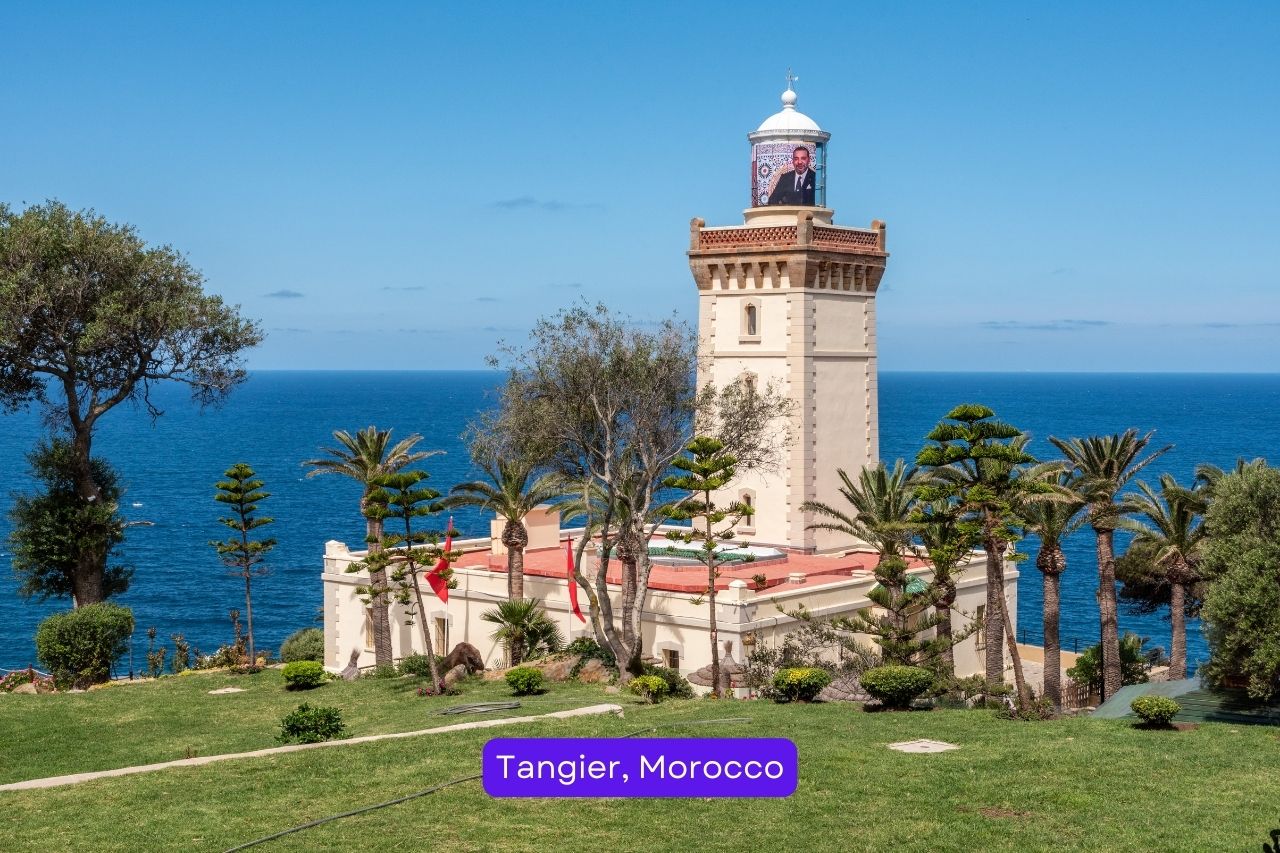The majority of people have vivid, busy images of Morocco in their minds, along with narrow, winding alleyways crowded with stores and residences. Morocco is well-known for its chaotic old cities, but what really sets this country in northern Africa apart is what’s on the other side of the walled city. Morocco has one of the most varied landscapes in the world, ranging from the wide plains of the Sahara to the windswept coastal villages. Morocco is a fantastic holiday destination when you include the imperial cities of Fez, Meknes, and Marrakesh with their amazing examples of early Islamic architecture and historical sites.
Rabat
When visiting the Atlantic Coast, Rabat, one of Morocco’s Imperial Cities, is a highly recommended destination. Rabat’s more serene ambiance can serve as a pleasant diversion from the bustling tourist scene of neighboring towns, despite it being smaller and less well-known than the Imperial towns of Marrakesh and Fes.

Hassan Tower
- Address: Bd Mohamed Lyazidi, Rabat, Morocco
- Opening hours: 06:30 – 22:45
- Entrance fee: Free
The unfinished Hassan Tower (Le Tour Hassan), constructed by the Almohads, was the brainchild of ruler Yacoub al-Mansour. It was intended to serve as the minaret for his ambitious proposal to build a great mosque on this location, one of the largest in the world. All that’s left of his grandiose proposal is this 45-meter-tall structure, which was left unfinished after his death in 1150. The tower’s front is covered in elaborately carved motifs and designs that allude to the opulence of what al-Mansour had in mind. Come here at dusk if you want to observe some local life; this is a very popular area for local families to hang out and stroll.
Kasbah of the Udayas
- Address: Av. Hassan II, Rabat, Morocco
- Opening hours: All day
- Entrance fee: Free
One of Rabat’s main tourist destinations is the Kasbah district. Surrounded by Andalusian-style dwellings, a small enclave of twisting pathways lies inside the 11th-century fortress walls. This is a great place for a leisurely walk, and the little blue-and-white alleys provide lots of photo ops.
Located at the southernmost point of the Kasbah are the serene Andalusian Gardens. This pleasant grassy area is a great place to let kids run around without worrying about automobiles or delivery riders if you’re traveling with little children. There is no shortage of shade in the gardens thanks to the orange and palm trees, and there are fountains all along the paths.
For pictures, go to the northern edge of the district, where a platform provides sweeping views of Salé to the north and the Atlantic Ocean to the west.
The 12th-century Bab Oudaia, located in the southern wall of the Kasbah, is the most striking entrance. The Kasbah Mosque is Rabat’s oldest mosque and can be reached from Bab Oudaia via Rue el Jamma’s main route.
Mausoleum of Mohammed V
- Address: 25FH+3C2, Rabat, Morocco
- Opening hours: 08:00 – 18:00
- Entrance fee: Free
The dazzling Mausoleum of King Mohammed V was constructed on the exact spot where, after his return from exile in Madagascar, he assembled thousands of Moroccans to express gratitude to God for their nation’s independence. The lavish tomb chamber, richly embellished with zellige tile work adorning the walls surrounding the imposing marble tomb, is a display of Moroccan traditional design.
Non-Muslims are not allowed inside the adjacent mosque, but they are allowed to observe the mausoleum’s tomb chamber from the terrace above—as long as they wear modest clothing with their knees and shoulders covered.
Chellah
- Address: Rabat, Morocco
- Opening hours: 08:30 – 18:30
- Entrance fee: 70 DH
Around 40 CE, the Romans seized possession of this stunning hilltop location above the bountiful Bou Regreg river plain, having previously been occupied by the Phoenicians. It was deserted starting in 1154 and remained so until the 14th century, when a Merinid sultan constructed a necropolis atop the Roman remains. All that remains of the once-impressive mosque is a beautiful minaret, crowned by a stork’s nest, and below it, the sultan’s tomb, complete with mosaic remnants and stone carvings.
Several saints’ tombs may be found to its right (east), as can the Bassin aux Anguilles, a pool that draws women who think that giving boiled eggs to the local eels can increase fertility and facilitate labor. A modest medersa (school for studying the Quran) with student cells, a mihrab (niche showing the direction of Mecca), and an ornamental pool is located next to the tower on a lower level. There is a shaded promenade with flowers, palm trees, and bamboo at the base of the site, beneath the grave of Sultan Abu Al Hasan and his wife.
Mohammed VI Museum of Modern and Contemporary Art
- Address: 2 Av. Moulay Hassan, Rabat, Morocco
- Opening hours: 10:00 – 18:00 (except Monday, Tuesday)
- Entrance fee as follows
| Category | Fee (DH) |
| Child under 12 years old | 10 |
| Young 12-18 years old | 20 |
| Adult | 40 |
One of the best things to do in Rabat is visit this museum if you’re interested in Moroccan modern art. The modest permanent collection, which is kept in an imposingly refurbished French colonial-era structure, includes pieces by almost all of the leading artists in the nation from the middle of the 20th century to the present. Additionally, a schedule of transient exhibitions with both foreign and local artists is available. nA visit here reveals the modern side of Morocco’s extensive artistic expressions and provides a delightful contrast to viewing the traditional artisan work for which the country is justly renowned.
National Zoo Rabat Morocco
- Address: Annexe 23eme, (Ceinture verte), Cité Yacoub El Mansour,, Rabat, Morocco
- Opening hours: 10:00 – 17:00
- Entrance fee as follows
| Category | Fee (Dhs) |
| Child under 03 years old | Free |
| Child 03-12 years old | 50 |
| Adult | 70 |
| Family 02 adults + 01 child | 170 |
| Family 02 adults + 02 children | 200 |
With its great biodiversity, the National Zoo of Rabat, Morocco, which opened in 1973 and has remnants of culture and history across the entire city, is home to hundreds of different species of enigmatic animals from Africa, Asia, and many other continents. It is also noteworthy that the facility’s museum holds the heritage of animal fossils found in Morocco that date back to the paleontological epoch.
The lion, tiger, elephant, zebra, rhino, and gorilla are some of the most fascinating creatures in the zoo. Feathered lemurs that reside in the treetops are also visible, along with other native animal species. Select the zoo tour if you’d like to learn more about the animals and explore the actual natural habitats of the animals while strolling about with your guide.
Marrakech
Marrakech’s winding pathways will take you to some fascinating place no matter where you turn, from palaces decorated in mosaics to picture-perfect parks to spice-scented medinas. Situated in the foot of the Atlas Mountains along the historic Silk Road path, the city is a mingling pot of culinary traditions, legends, and cultural influences.

Jardin Majorelle
- Address: Rue Yves St Laurent, Marrakech 40090, Morocco
- Opening hours: 08:30 – 18:00
- Entrance fee as follows
| Category | Fee (MAD) |
| Child under 10 years old | Free |
| Child from 10 years old/ Student | 80 |
| Adult | 155 |
One of Marrakech’s most picturesque locations is the Majorelle Garden (Jardin Majorelle), with its striking blue color scheme, tall palms, and enormous cactus arranged around pools of water lilies and gardens full of exotic plants. One of the most popular tourist destinations in the city, it is owned by designer Yves Saint Laurent. Majorelle’s former painting studio is now housed within the grounds of a fantastic museum honoring Berber craftsmanship. Adjacent to the gardens’ entryway is a museum honoring Yves Saint Laurent’s life and contributions to fashion, along with a schedule of rotating exhibitions.
Bahia Palace
- Address: Marrakesh 40000, Morocco
- Opening hours: 08:00 – 17:00
- Entrance fee: 70 MAD
The Bahia Palace’s name, Palais Bahia, alludes to its magnificence: “Bahia” means “Brilliance.” Si Ahmed ben Musa, also known as Ba Ahmed, was the Grand Vizier of Marrakech’s house in the 19th century. The palace is situated on the northern edge of the Jewish quarter, the medina, and is part of the UNESCO-listed Marrakech medina.
The interior design showcases the luxurious lifestyles of those high up in the sultan’s favor at the time with a stunning exhibition of Moroccan artisan work that combines painted ceilings, zellige tiles, and elaborate wrought-iron elements.
The two main attractions are the enormous marble grand courtyard and the lavish salons of the haram area; the lush internal courtyard of the great riad, with its citrus trees and banana-leaf plants, offers a peaceful escape from the bustle of the city.
Saadian Tombs
- Address: Rue de La Kasbah, Marrakesh 40000, Morocco
- Opening hours: 09:00 – 17:00
- Entrance fee: 60 MAD
More than 200 crypts belonging to Saadian dynasty members may be found in the Saadian Tombs (Tombeaux Saadiens), which were built in the sixteenth century by Sultan Ahmad al-Mansur. The spectacular mausoleums are known for their opulent style, which includes gold and marble embellishments, excellent woodwork, and stunning zellige tiles.
Owing to their ideal position, which is only a short walk from El Badi Palace, the Saadian Tombs are a frequently visited site on Marrakech city tours and day trips from places like Essaouira or Casablanca. The magnificent tomb of Sultan Ahmad el-Mansur’s mother is the focal point of the lovely gardens, where guests may also tour the two mausoleums, which include the Hall of Twelve Columns, which contains Ahmad el-Mansur’s tomb.
Madrasa Ben Youssef
- Address: Rue Assouel, Marrakech 40000, Morocco
- Opening hours: 09:00 – 18:00
- Entrance fee: 50 DH/adult & 10 DH/child under 12 years old
Ben Youssef Madrasa in the bustling medina of Marrakech has been a temple of learning for more than 500 years. Although students no longer study Islamic law or recite the Quran here, tourists may still take in the unique atmosphere and exquisite Andalusian architectural aspects of the school. pDeceptively modest, the wooden door at the tiny entry to Ben Youssef Madrasa is hardly more than an inconsequential storefront. And once you’re inside this 16th-century madrasa’s grand courtyard with its glistening reflection pond and bright, detailed mosaics, the inscription at the entrance, “You who enter my door, may your highest hopes be exceeded,” plays like a playful jab.
Koutoubia
- Address: Marrakesh 40000, Morocco
- Opening hours: 08:00 – 20:00 (except Saturday, Sunday)
- Entrance fee: Free
One well-known monument in Marrakech, Morocco, is the Koutoubia Mosque. One of the nation’s oldest and most magnificent mosques, it was constructed in the twelfth century. It is a famous tourist site because of its grandeur and beauty, and it serves as a symbol of the rich history and culture of the city.
The renowned architect Abu Yusuf Yaqub al-Mansur created the Koutoubia Mosque. He created a stunning and remarkable building by fusing together the architectural elements of Andalusian and Islamic design. The mosque boasts a massive minaret that is 77 meters tall and is constructed out of red sandstone. A copper globe and crescent moon are perched atop the elaborately carved minaret.
Jemaa el-Fnaa
- Address: Marrakesh 40000, Morocco
- Opening hours: All day
- Entrance fee: Free
The hub of Marrakech life, Jemaa el-Fna (also written Djemaa el-Fna or Jemaa el-Fnaa) is an outdoor market by day and a bustling hub of diners, shoppers, storytellers, and singers by night. Locals and visitors flock here night after night to take in the clash of colors, sounds, smells, and sights that make up this iconic location.
For nearly a millennium, Moroccans have gathered at Jemaa el-Fna, the Medina (walled town) of Marrakech. A visit to the square, especially after dark, is a truly unique experience, with everything from the snake charmers and traditional storytellers spinning their tales to rapt groups of locals to the many food vendors selling sweet mint tea and traditional snail soup.
Badi Palace
- Address: Ksibat Nhass, Marrakech 40000, Morocco
- Opening hours: 09:00 – 17:00
- Entrance fee: 70 DH
One of the most intriguing views in the kasbah area is the remains of Al-Mansour’s once great palace. During his glorious reign, the Saadian ruler constructed the lavish palace, which had pavilions surrounded by a vast park of reflecting pools. However, it was soon destroyed by looters. All that’s left now are the tall enclosing walls, the destroyed pavilions, and the meager remains of mosaic-tiled flooring. From the top of the walls, where storks have made their nests, there are great views across the medina.
Yves Saint Laurent Museum
- Address: Rue Yves St Laurent, Marrakech 40000, Morocco
- Opening hours: 10:00 – 18:00 (except Wednesday)
- Entrance fee as follows
| Category | Fee (DH) |
| Child under 10 years old | Free |
| Child from 10 years old/ Student | 70 |
| Adult | 135 |
The new 4,000 m² structure, which is located close to the Jardin Majorelle, which Yves Saint Laurent and Pierre Bergé purchased in 1980, will have a 400 m² permanent exhibition space that was created by Christophe Martin and will highlight Yves Saint Laurent’s fashion designs. As they perused the designer’s archives, they were drawn to the series of delicate and striking shapes that typified Yves Saint Laurent’s creations: curves next to straight lines. The building’s facade is shaped like a cube meeting a lace-like layer of bricks, forming patterns reminiscent of the warp and weft of cloth. The mYSLm will be more than simply a museum; it will also have a research library with over 6,000 volumes, a 150-seat theater, a bookstore, and a terrace café. Temporary exhibition space will also be included.
Fez
Fez is Morocco’s best city for historical sightseeing, with historic monuments tucked away around every bend in the winding, narrow alleyways and a skyline broken up by domes and minarets. The medina’s souks offer some of the best shopping experiences in the nation.

Medina of Fez
The Fez Medina, also known as Fes El-Bali, forms the northeast corner of the city and offers a bewildering introduction to its crafts, culture, and bustle. Encircled by 13th-century walls and ornate gates, this maze of streets, shops, and souks is designated by UNESCO and dates back to the 9th century.
The pedestrian-only medina of Fez is teeming with crumbling buildings, carved doorways, and riad palaces that coexist with tanneries, mosques, tombs, and many stores selling leather, spices, and pottery. Highlights include the renowned Kairaouine Mosque University, which is regarded as the oldest in the world, and the exquisite Bou Inania and Al-Attarine madrasas (Islamic schools) are tucked away inside. First-time tourists should definitely take a guided tour as navigating the medina might be challenging.
Volubilis
The Roman ruins of Volubilis, which stretch across the Jebel Zerhoun plateau in northern Morocco, are a remarkable sight, especially during the summer when they are ablaze with wildflowers. This UNESCO World Heritage site, which has some of the best-preserved ruins in Northern Africa, provides a window into ancient Morocco and is a pleasant day trip from Fez or Meknes.
The importance of Volubilis, a Carthaginian administrative hub of the Mauretania kingdom in the third century BC, rested on its exports of grain and olive oil to Rome. The settlement and its assortment of structures, including temples, olive mills, and the stunning floor mosaics in the Triumphal Arch of Caracalla, which was constructed to honor the Roman Emperor’s passing, are still surrounded by the ruins of protective stone walls today.
Marinid Tombs
- Address: 329C+X64, Fes, Morocco
- Opening hours: All day
- Entrance fee: Free
Located on a hill above and to the north of Fes al-Bali, the ancient city of Fez, Morocco, is a group of abandoned massive tombs known as the Marinid Tombs or Merenid Tombs. When the Marinid dynasty ruled Morocco from the 13th to the 15th century, they were first a royal necropolis. This dynasty was significant to Morocco’s political and cultural history.They serve as a well-liked vantage point over the old city nowadays.
The Royal Palace in Fez
- Address: n1 boulakhsissat, Fès 33110, Morocco
- Opening hours: All day
- Entrance fee: Free
The 13th century saw the construction of the Royal Palace, which is situated in the heart of the Fes el Jadid neighborhood. The King of Morocco still stays at the Royal Palace of Fez (Fes Dar el-Makhzen), which was once the sultan’s primary residence while he is in the city of Fez. Enclosed between tall walls, it covers an expanse of 195 acres (80 hectares). It is nonetheless worthwhile to view the palace’s façade, especially the stunningly elaborate gates at the entry, even though tourists are not allowed inside. There are seven brass doors in various sizes, encircled by exquisite zellige (mosaic tilework) and carved cedar wood, with matching knockers and geometric patterns.
Dar Batha Museum
- Address: Oued Fejjaline، 5 Ave du Batha, Fes, Morocco
- Opening hours: 08:30 – 18:00
- Entrance fee: 10 Dhs
The Dar Batha Museum (Museum of Moroccan Arts), one of Fez’s most renowned museums, is home to a vibrant collection of Moroccan arts and crafts and is a valuable addition to any sightseeing tour, providing a unique insight into Fez’s cultural legacy.
With objects ranging from the 14th century to the present, the extensive permanent collection features everything from hand-painted pottery to antique Berber carpets to gold-plated astrolabes. Traditional jewelry, leatherwork, earthenware, woodwork, and embroidery are all shown. The museum is set in a stunning 19th-century Hispano-Moorish palace designed by Moulay el Hassan, and the grounds are equally breathtaking, with a peaceful garden and café.
Al Attarine Madrasa
- Address: 328G+2GJ, Rue Talaa Kebira, Fes, Morocco
- Opening hours: 08:00 – 18:00
- Entrance fee: 20 Dhs
The 14th-century Al-Attarine Madrasa (Medersa el-Attarine is a monument to medieval Moroccan workmanship and is one of the most exquisite Islamic universities in all of Fez. The prayer hall and courtyard are embellished with exquisite mosaic tiles, intricate plasterwork, and exquisitely carved cedar, while the upstairs chambers demonstrate the modest lifestyles of the aspirant scholars. This serenely lovely area is often included on walking tours of the Fez medina; it’s the ideal escape from the bustle of the small streets outside.
Casablanca
Due to its location as the key international airport, Casablanca serves as both the main entry point and the initial impression of Morocco for many tourists. Morocco’s industrial and business hub, this vibrant metropolis has a contemporary flair not found in other regions of the nation. Even while Casablanca may not have many tourist sites or activities, if you look a little closer, you can uncover some hidden treasures.

Hassan II Mosque
- Address: Boulevard de la Corniche, Casablanca, Morocco
- Opening hours: 09:00 – 15:00
- Entrance fee as follows
| Category | Fee (Dhs) |
| Child under 06 years old | Free |
| Child from 06 years old | 30 |
| Student | 65 |
| Adult | 130 |
The Hassan II Mosque, which dominates the entire city, is located on the seashore, just beyond the northern extremity of Casablanca’s medina (old city). Completed in 1993, this mosque occupies two hectares and boasts the world’s highest minaret, standing at a height of 200 meters. It is the second largest mosque globally. There is space for 25,000 worshipers in the prayer hall and an additional 80,000 in the courtyard, which has a retractable cover.
Church of Notre Dame of Lourdes
- Address: H9MM+3Q7, Casablanca 20250, Morocco
- Opening hours: 08:30 – 19:00
- Entrance fee: Free
This 1956 Catholic church is a remarkable example of European modernist architecture. Notable features include its extended concrete entrance and its exquisite stained-glass windows, which were created by renowned French artist Gabriel Loire. Upon its completion, a little crucifix is mounted to the large concrete “hood,” which rises above the church’s doors and is the most striking external feature. Although this is one of the church’s most notable architectural features, everyone’s eyes are drawn to the extremely stunning stained glass windows.
Museum of Moroccan Judaism
- Address: 81 Rue du chasseur Jules Gros, Casablanca, Morocco
- Opening hours: 10:00 – 15:00 (Monday – Thursday) | 10:00 – 12:00 (Friday)
- Entrance fee: 50 Dhs
This elegant home in the affluent, peaceful Oasis neighborhood of Casablanca is devoted to the 2,000-year history of the Jewish community in Morocco. The mansion itself was once a Jewish orphanage and has a long history with the neighborhood’s Jewish community.
Exhibited here are photographs, traditional costumes, religious artifacts, and dioramas that trace the rich history of Moroccan Jews, with a focus on the Jewish community of Casablanca. The exhibits’ cultural relevance and historical background are fully explained by the abundant labeling throughout the collection.
Mohammed V Square
- Address: H9RJ+FGP7, Casablanca 20250, Morocco
- Opening hours: All day
- Entrance fee: Free
Mohammed V Square, the focal point of the vibrant new town of Casablanca, is surrounded by some of the city’s most remarkable architectural designs. The plaza, which was designed in the early 20th century and named after the former Sultan, is centered around a colossal fountain that is magnificently illuminated at night.
Numerous significant administrative buildings in Casablanca are located in and around the plaza; these structures showcase the magnificent Mauresque and Art Deco architectural styles that were prominent during the French colonial era, as imagined by French architect Henri Prost.
Royal Palace
Address: 19 Rue de Rome, Casablanca, Morocco
When the King of Morocco is in town, he stays at the Royal Palace of Casablanca, a magnificent example of Islamic architecture set amid lovely orange trees and ornate water features. Situated in the New Medina’s Habous Quarter, this is the King’s primary Casablancan palace and serves as the venue for royal receptions all year round.
The monument, which highlights the intriguing history and architecture of the nation, is a well-liked destination on tours even though the palace grounds are off-limits to the general public. Tourists snap pictures of the royal guards standing guard over the gate and enjoy the large open square with gushing fountains in front.
Tangier
With winding city streets, a hilltop medina, and nearby beaches set against a rich cultural tapestry, Tangier offers things to do for adventurers, romantics, and historians alike. Spend some time admiring the whitewashed façades of the inner city; with its skinny alleyways and vibrant shops, it embodies a certain charm that can’t be found elsewhere in the region.

Hercules Caves
- Address: Q356+X8C, Tanger, Morocco
- Opening hours: 10:00 – 17:30
- Entrance fee: Free
One of the main attractions in the area is the Caves of Hercules, which are 7 miles (14 kilometers) west of Tangier, close to Cape Spartel. The 18.6-mile (30-kilometer) cave was found in 1906 and is a combination of natural and man-made features.
The mythological hero Hercules, who is said to have slept in the cave prior to one of his twelve fabled labors, is responsible for the name of the cave system. Since prehistoric times, it has been utilized; most recently, the Berbers used it to create millstones, which contributed to the expansion of the cave system. The indentations on the cave ceiling and walls are still visible. One of the most fascinating features of the cave is the “Map of Africa,” which is thought to have been made by the Phoenicians. Remember to enjoy the breathtaking views of the ocean from the cave’s interior.
Kasbah Museum
- Address: Pl. de la Kasbah, Tanger 90030, Morocco
- Opening hours: 10:00 – 18:00 (except Monday, Tuesday)
- Entrance fee: 60 Dhs
Located in Dar El Makhzen, the former sultan’s palace, is this recently renovated museum. The history of the region from prehistoric times to the 19th century is the main topic of discussion. Make your way around the first courtyard in an anticlockwise direction before going inside to see the other exhibits and taking a stroll in the quaint Andalusian Garden.
The enormous reproduction maps, along with the statues and mosaic of Venus from Volubilis, are especially noteworthy. The first map shows trade lines from the Phoenician metal trade to the 21st-century technological commodities; the second map, created in Tangier in 1154, is an exquisite map of the known world (hint: it’s upside down from the viewer’s perspective).
Cap Spartel
- Address: 1.14km Achakar commun de Tanger, Morocco
- Opening hours: 08:30 – 23:30
- Entrance fee: Free
Cape Spartel marks the northwest corner of Africa, where the Atlantic and Mediterranean oceans converge, and is situated west of Tangier. Cape Spartel, which rises to a height of 1,000 feet (305 meters) above sea level, is well-known for its breathtaking views, dramatic coastline roads, and an 1864 lighthouse. When the sky is clear, you can see all the way from the Rock of Gibraltar to Cape Trafalgar along the Spanish coast. Visitors can easily spend a few hours here, as there are plenty of surrounding sandy beaches and walking and hiking routes.

